The epidermophytosis of the feet is a fungal disease, caused by the pathogens of dermatophytes who have settled on the skin of a person, of the genus of Trichophytons.
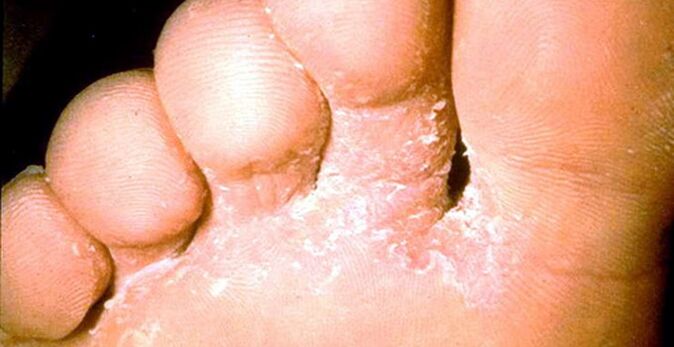
There is a complex infection of nails and skin in the feet and between the toes that are interconnected.
Diseases of certain professions that are in heat and high humidity, favorable to the development of fungi are particularly sensitive to diseases - they are athletes, minors or people simply do not follow their feet hygiene.
The reasons for appearance
The main condition for the appearance of the disease is infection of the skin of the legs, that is to say the entrance to the fungal dispute.This occurs in public places or in direct contact with the carrier via personal hygiene products, for example, shoes or socks.
The main accumulation places of various mushrooms are public showers, baths, saunas, changing rooms, etc.
In addition, favorable conditions should be created for the development of the fungus, which is facilitated by the following factors:
- Increased humidity;
- Leg sweating;
- long -term port of uncomfortable shoes;
- Low quality socks or shoes with insufficient ventilation;
- Professional activities (sports, work), when the legs are in constant heat and experience a water envelope;
- venous thrombosis;
- Blood vessel disease;
- diabetes mellitus;
- weaken immunity;
- overwork;
- Stress and nervouscas.
The fungus is not always activated when it rises on the feet, because the body has its own protective functions.The disease occurs only in the presence of pathologies.
For example, the socks press blood vessels and the blood supply level is reduced, or the legs are constantly hot with high humidity and the acidity of the skin decreases, creating favorable conditions.
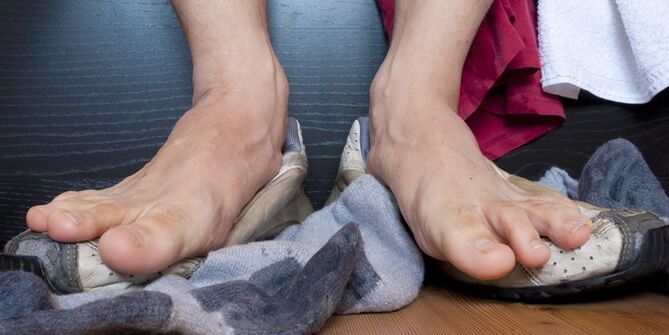
This is also facilitated by stress and overwork which reduce the protection of the body against pathogens.
Mushroom symptoms and stages
The disease is characterized by forms and stages of epidermophytosis.The main symptoms characteristic of all forms are the skin and redness of the skin between the toes and on the feet.There are four stages of the disease:
Erased or soft step
Between the toes, light foci of peeling of the skin are observed, the feet are clean.The patient hardly feels discomfort or other unpleasant symptoms.
Epidermoid-hyperkeratic scene
At this stage, the disease manifests itself more clearly.On the phalanges of the fingers and them, as well as on the sides of the feet, there are seals of the skin of a brown or bluish shade.
The skin takes off on dry scales.The patient has increased drought in the legs.Forms of white and yellow may seem similar to the cors.
Infected places give rise to itching.An unpleasant smell comes from the legs.
Intriginal phase
The legs are constantly wet and charming.Between the toes, there are similarities of edema.White or yellow skin bloating appear.
The skin peels off the entire surface of the feet and toes.There may be wounds, cracks and erosion, which sometimes bleed, if they are damaged.
The patient experiences constant discomfort, itching or weak pain, especially when walking.The skin detachment is important, as well as the seals.
Dyshidrotic step
Throughout the surface of the feet and between the toes, formations resembling bubbles appear.They accumulate a liquid that ooys damage to the bubble walls.
After that, swelling and inflammation of the skin can occur.The feet and fingers are constantly itching, and the legs acquire a strong smell of mold which cannot be removed by soap or other means.
Complications
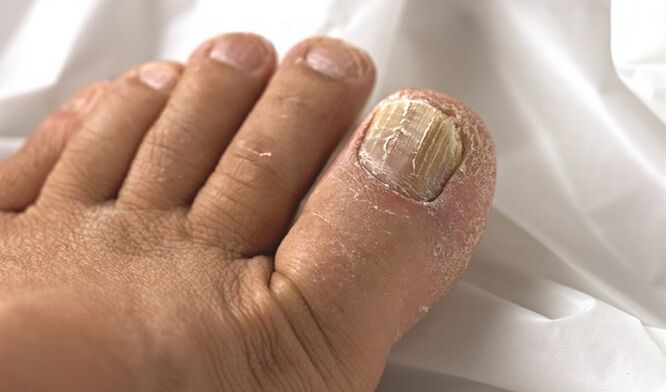
In addition, the disease falls on the nails which gradually become yellow, then deform and exfoliate.This happens in each third case of epidermophytic, if it is tightened with treatment.
In the most advanced cases, the fungus "throws" into other parts of the body, causing the appearance of stains on the skin, an allergic reaction or other pathologies.
Treatment
To treat the disease, you must contact a mycologist.Various tests and studies will be carried out on the basis of which an appropriate treatment will be prescribed.
Therapy aims to destroy the fungus.For this, funds are used both for internal and more local use, at the same time.
Drugs
The treatment of the fungus occurs at home and lasts, depending on the scene, from 2 to 3 months to 1 year.To remove the interior fungus activity, use the 2-Chlorin-4-Nitrophenol medication.
In parallel, the affected areas must be treated with local medicines (creams, gels, ointments):
- Clotrimazole.
- Tolnaftat.
- Mikonazole.
- Terbinafine.
- Econazole nitrate.
- Naphyfine and others chlorhydrate.
When purulent secretions and inflammation appear, itraconazole is generally prescribed.A systematic approach allows you to manage the infection more effectively.
The choice of drugs and the course of treatment are carried out by the attending physician on the basis of the clinical picture.
Folk remedies
The means of traditional medicine are used as an additional measure of the fight against the fungus, but not independent.
Popular recipes can only help in the early stages of the disease.Consider some of them:

- Salicylic vaseline and acid.For 1 teaspoon of petroleum jelly, half of the aspirin or salicylic acid tablet is taken, mixed and applied to the area between the toes, slightly rubbed.This will help stop the propagation of the fungus and relieve the unpleasant symptoms.
- A decoction of herbs.The following herbs which have an antifungal and anti-inflammatory effect must be taken: chamomile, quarrel, thousandpertuis and eucalyptus leaves.All herbs are taken in equal quantities (1 teaspoon per 0.5 l of water).The water is brought to the boil and boiled for 10 minutes, after which it is also insisted for 30 minutes.In the decoction, the legs are soaring, gradually adding hot water.
- Sea land oil.A cotton swab is moistened in the oil, which wipes the affected areas.It is a good antiseptic that relieves pain, itching and inflammation.
- Soda, salt and soap.In a hot water pool, a piece of clothes soap and 1 tablespoon of soda and salt are dissolved.The leg adjustment procedure is carried out every day, preferably before bedtime.This will help clean the skin of the keratinized parts and better affect the effectiveness of drugs that penetrate more deeply into the tissues of the fingers and feet.
- Boric acid.For treatment, a solution (2%) of boric acid is used, which wipes the legs with a cotton swab.It is a strong antiseptic for mushrooms.However, you must be careful and not carry out the procedure too often so as not to burn chemical.
Shoes and underwear
In addition to direct treatment, you should always monitor the condition of shoes and linen.This is important because therapy can have a meaning if it is neglected by hygiene.
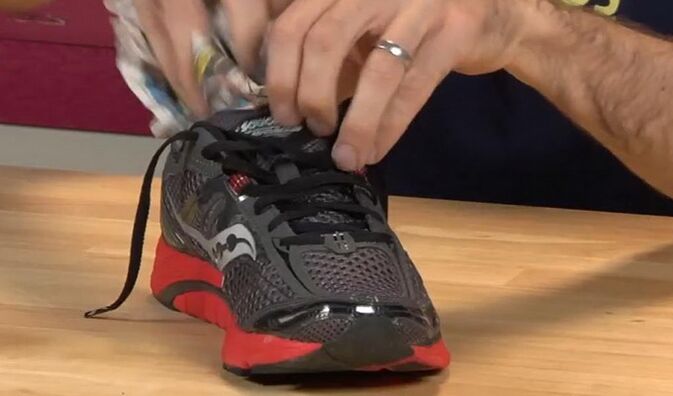
Shoes should be constantly dried and socks can be changed every day.It is useful to treat daily shoes with formalin for disinfection.
After carrying out water procedures, the legs are completely wiped with a clean dry towel, especially between the toes.Then immediately apply creams or medicinal ointments that the doctor prescribed.
With increased sweating of the legs, a decoction or an oak bark infusion, as well as ordinary vinegar, helps.
The main thing is to keep your legs still dry, because humidity is a favorable environment for the development of the fungus.
Prevention
There are a number of preventive measures aimed at preventing relapse or infection by a fungus on the legs:
- Wash your legs several times a day, wiping them;
- You cannot use the socks, shoes or a towel for others;
- Daily shoes must always be dried before using;
- In public places, use slippers or other shoes, then use disinfectants to reduce the risk of infection;
- Shoes should be comfortable and not cause leg sweating;
- Visit a doctor regularly for preventive exams for any disease;
- eat properly;
- Reduce the use of alcohol and sweet foods.
Conclusion
Epidermophytosis is a very unpleasant disease because it spoils the appearance of the legs and causes a strong unpleasant odor.
The legs are constantly sweating and starting to really stink.This interferes with normal life and spoils a person.
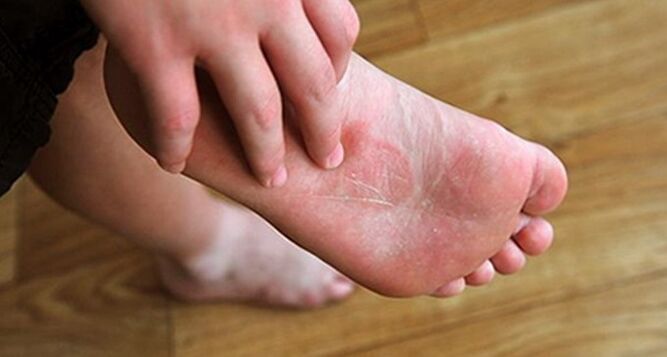
First of all, the disease affects personal life and, therefore, the treatment should start at the first symptoms, given the risk of infection by the mushroom of others.
At the initial stage, the disease is easily therapeutic and recovery occurs after a few months.However, in advanced condition, it can take a year or more, so it is not necessary to delay.


















